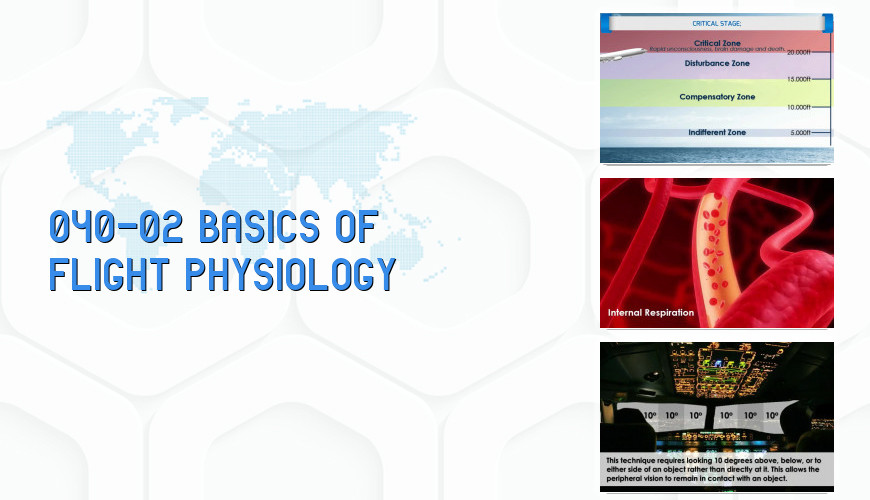
Course Information
The atmosphere is a mixture of gases of constant proportions which are: Oxygen 21%, Nitrogen78%, Other gases 1%. As altitude increases, pressure and density decrease and the amount of oxygen available to the red blood cells decreases. The atmosphere is measured in millimetres of mercury (mmHg) and inches of mercury (inHg). The volume percentage of the gases in ambient air will remain constant for all altitudes at which conventional aircraft operate. As altitude increases, the pressure of the gases decreases, making it necessary to have some additional source of oxygen. Courses are constantly monitored and updated when major changes in authority documentation is released.
Content of the Course
| Slide | 204 | Duration | 2:04:31 | Exam | No |
|---|
- COURSE START
- BASICS OF FLIGHT PHYSIOLOGY / THE ATMOSPHERE
- The gas laws:
- The Law Of Diffusion
- Isa Condition
- Respiratory And Circulatory Systems / Respiratory Systems
- Circulatory Systems
- Blood
- Anaemia
- Hypertension And Hypotension
- The Effects Of High And Low Blood Pressure On The Body
- Coronary Artery Disease
- What are the risk factors for heart disease?
- Hypoxia
- Summary Of Oxygen Requirements By Altitude
- Time Of Useful Consciousness (Tuc)
- Hyperventilation
- Hyperventilation And Hypoxia
- Aircraft Pressurization System
- Decompression Sickness (Dcs)
- High Altitude Environment / Ozone
- Radiation
- Humidity
- Extreme Temperature / Hot Environment And Hyperthermia
- Cold Environment And Hypothermia
- MAN AND ENVIRONMENT – THE SENSORY SYSTEM
- Central, Peripheral And Autonomic Nervous Systems / Human Nervous System
- The Autonomic Nervous System (Ans)
- Level Of Threshold
- Sensory Adaptation
- Vision / Functional Anatomy
- Anatomy And Physiology Of The Eye
- Parts Of Eyes
- Cornea – Lens – Ciliary Body Muscles
- Iris – Pupil
- Rods
- Cones
- Visual Foveal And Peripheral Vision
- Light And Dark Adaptation
- Binocular And Monocular Vision
- Distance Estimation And Depth Perception
- Stereoscopic Vision / Binocular Cues
- Sunlight And Its Effect On The Eyes
- Eye Defects
- Hearing
- Descriptive And Functional Anatomy
- The Inner Ear
- Hearing Loss
- Equilibrium / Functional Anatomy
- Otoliths
- Motion Sickness
- Integration Of Sensory Inputs / Spatial Orientation
- Visual Illusions
- Visual Illusions Associated With Landing
- Slope Of Runway
- Black Hole Effect
- Rain On The Windshield
- Atmosphere – Low Contrast Environment
- Autokinesis
- Empty Field Myopia
- Vestibular Illusions
- Somatogravic
- G-Excess Illusion
- Coriolis
- Proprioception Sense – Seat Of Pants Sense
- Health And Hygiene / Personal Hygiene
- Body Rhythm And Sleep
- Fatigue Definitions
- Body Temperature
- Problem Areas For Pilots
- Gastro Intestinal Upsets – Abdominal Distension
- Obesity
- Back Pain
- Food Hygiene
- Step 1 / Step 2 / Step 3 / Step 4
- Tropical Climates
- Infectious Diseases
- Intoxication / Tobacco
- Caffeine
- Alcohol
- Drugs And Self-Medication
- Toxic Materials
- Incapacitation In Flight
- COURSE END
